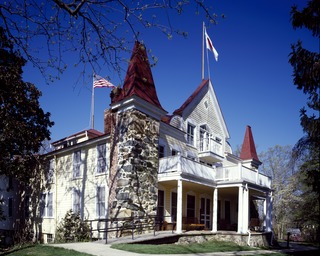
The Clara Barton National Historic Site, which includes the Clara Barton House, was established in 1974 to interpret the life of Clara Barton (1821–1912), an American pioneer teacher, nurse, and humanitarian who was the founder of the American Red Cross. The site is located 2 miles (3.2 km) northwest of Washington D.C. in Glen Echo, Maryland.

The South Fork Fishing and Hunting Club was a Pennsylvania corporation that operated an exclusive and secretive retreat at a mountain lake near South Fork, Pennsylvania, for more than 50 extremely wealthy men and their families.

The Cambria Iron Company of Johnstown, Pennsylvania was a major 19th-century industrial producer of iron and steel founded in 1852. The company had the nation's largest steel foundry in the 1870s and was renamed the Cambria Steel Company in 1898. The company used many innovations in the steelmaking process, including those of William Kelly and Henry Bessemer. The company was acquired in 1923 by the Bethlehem Steel Company. The company's historic facilities, extending some 12 miles (19 km) along the Conemaugh and Little Conemaugh Rivers, are a National Historic Landmark District.
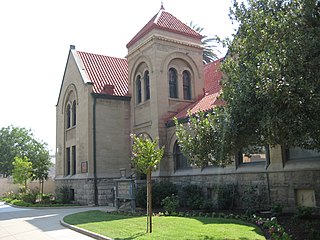
The Carnegie Museum of Kings County, is a museum in Hanford, Kings County, central California.
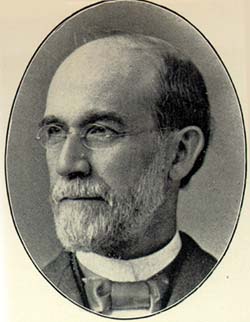
Addison Hutton (1834–1916) was a Philadelphia architect who designed prominent residences in Philadelphia and its suburbs, plus courthouses, hospitals, and libraries, including the Ridgway Library, now Philadelphia High School for the Creative and Performing Arts, and the Historical Society of Pennsylvania. He made major additions to the campuses of Westtown School, George School, Swarthmore College, Bryn Mawr College, Haverford College, and Lehigh University.

The Johnstown Flood Museum is a history museum located in Johnstown, Pennsylvania, dedicated to the Johnstown Flood of 1889. The museum is housed in the former Cambria Public Library, which is part of the Downtown Johnstown Historic District.
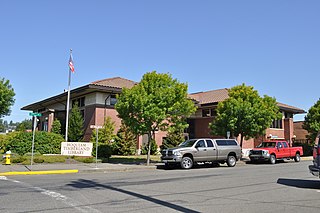
The Carnegie Library is a historic building still in use as the Hoquiam Timberland Library in Hoquiam, Washington.

The North Bend Carnegie Library is a Carnegie library located at 140 E. 8th St. in North Bend, Nebraska. The library was funded by the Carnegie Foundation in 1911 and dedicated in 1913; it housed a library program started by the city's Woman's Club in 1906. The building was designed by John R. Smith according to the simple plans suggested by the Carnegie Foundation. The city used the library until 2012, when they vacated it for a new building.

The Chadron Public Library, at 507 Bordeaux St. in Chadron, Nebraska, is a historic Carnegie library in a Classical Revival-style building designed by architect George A. Berlinghof. It was listed on the National Register of Historic Places in 1990.

Fairfield Public Library is located in Fairfield, Iowa, United States. A library association was founded by a group of local men in 1853, and funded by dues from its members. It was housed in several different buildings for the first 40 years. U.S. Senator James F. Wilson from Fairfield was instrumental in obtaining a grant from Andrew Carnegie for a building of its own. The grant for $40,000 was accepted on January 15, 1892. It was the first Carnegie Library outside of Western Pennsylvania and the first of 101 built in Iowa. It was also one the few libraries Carnegie funded without stipulations concerning its use, public support, or design. The building was designed in the Richardsonian Romanesque style by Kansas City architect C. Stafford. It was officially opened on Friday, September 29, 1893, and it was dedicated on November 28 of the same year. The association continued to run the library until 1899 when voters approved a referendum to support it with taxes. The building has been altered in the ensuing years, and it was listed on the National Register of Historic Places in 1983. The library moved to a new building in 1996, and the historic building is now home to the Jefferson County Service Center of Indian Hills Community College.

The Plainview Carnegie Library in Plainview, Nebraska is a Carnegie library which was built in 1916–1917. It was listed on the National Register of Historic Places in 1993.
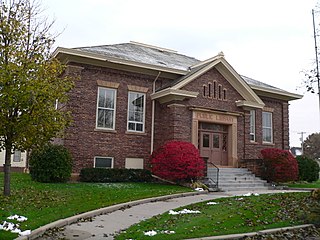
The Norfolk Carnegie Library in Norfolk, Nebraska is a Carnegie library which was built in 1910. It was listed on the National Register of Historic Places in 1998.
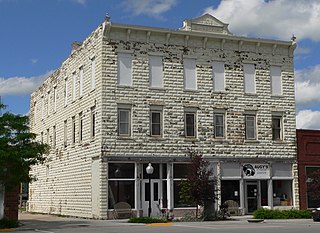
The Hub Building in Burwell, Nebraska, also known as the Burwell's Modern Cash Department Store, was built in 1906. It was listed on the National Register of Historic Places in 2006.

The Loup City Township Carnegie Library is a historic building in Loup City, Nebraska. It was built as a Carnegie library in 1917 by John Ohlson & Sons after members of the community applied for a grant from the Carnegie Corporation. The cornerstone was laid by the Grand Lodge of Nebraska in January 1917, and the library was dedicated on September 3, 1917. The building was designed in the Classical Revival style by Fiske & Meginnis. It has been listed on the National Register of Historic Places since December 27, 2007.

The Sidney Carnegie Library is a historic building in Sidney, Nebraska. It was built in 1914 as a Carnegie library with funding from the Carnegie Corporation, and designed in the Tudor Revival architectural style. There is a grotesque on each side of the main entrance. When the building was dedicated in 1917, it was the first public library in Cheyenne County, Nebraska. A new public library building was built in 1967, and this building was repurposed as the Cheyenne County Chamber of Commerce. It has been listed on the National Register of Historic Places since July 3, 1991.
The Albion Carnegie Library, at 437 S. 3rd St. in Albion, Nebraska, is a Carnegie library built in 1908 which was listed on the National Register of Historic Places in 2019.

The McCook Public-Carnegie Library, also known as the McCook Carnegie Library, is a historic building in McCook, Nebraska, United States. It was built as a Carnegie library in 1905, and designed in the Spanish Colonial Revival style by Denver architect Willis Marean. It housed the McCook public library until 1969. Since then, it has housed the Museum of the High Plains. The building has been listed on the National Register of Historic Places since September 12, 1985.

The Fairbury Public Library is a library in Fairbury, Nebraska. Its building was constructed in 1908-09 as a Carnegie library with funding from the Carnegie Corporation. It was designed in the Classical Revival style by Tyler and Son, an architectural firm co-founded by English-born James Tyler and his son, James Tyler Jr. The facade includes two sets of columns and a tympanum with "cherubs holding a ring which encircles a shield." The first 100 books were donated by the Fairbury Woman's Club. The building was listed on the National Register of Historic Places on September 12, 1985 as Fairbury Public-Carnegie Library.
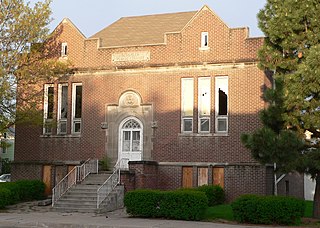
The Schuyler Carnegie Library is a historic building in Schuyler, Nebraska. It was built as a Carnegie library by P.H. Wind & Sons in 1911, and designed in the Tudor Revival style by the architectural firm Fisher & Lawrie. It was a library until 1975, and it housed the Schuyler / Colfax County Historical Society Museum from 1977 to 1998. It has been listed on the National Register of Historic Places since November 29, 2001.

The Longmont Carnegie Library, at 457 Fourth Ave. in Longmont, Colorado, is a Carnegie library which was completed in 1913. It was listed on the National Register of Historic Places in 1992, and was included as a contributing building in the Downtown Longmont Historic District in 2017.





















